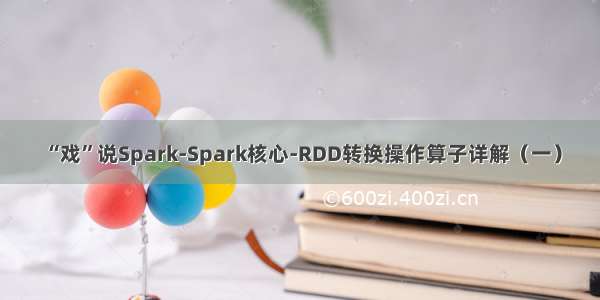
Transformation处理的数据为Key-Value形式的算子大致可以分为:输入分区与输出分区一对一、聚集、连接操作。
输入分区与输出分区一对一
mapValues
mapValues:针对(Key,Value)型数据中的Value进行Map操作,而不对Key进行处理。
方框代表RDD分区。a=>a+2代表只对( V1, 1)数据中的1进行加2操作,返回结果为3。
源码:
/**
* Pass each value in the key-value pair RDD through a map function without changing the keys;
* this also retains the original RDD's partitioning.
*/
def mapValues[U](f: V => U): RDD[(K, U)] = {
val cleanF = self.context.clean(f)
new MapPartitionsRDD[(K, U), (K, V)](self,
(context, pid, iter) => iter.map { case (k, v) => (k, cleanF(v)) },
preservesPartitioning = true)
}
单个RDD或两个RDD聚集
(1)combineByKey
combineByKey是对单个Rdd的聚合。相当于将元素为(Int,Int)的RDD转变为了(Int,Seq[Int])类型元素的RDD。
定义combineByKey算子的说明如下:
createCombiner: V => C, 在C不存在的情况下,如通过V创建seq C。mergeValue:(C, V) => C, 当C已经存在的情况下,需要merge,如把item V加到seqC中,或者叠加。mergeCombiners:(C,C) => C,合并两个C。partitioner: Partitioner(分区器),Shuffle时需要通过Partitioner的分区策略进行分区。mapSideCombine: Boolean=true, 为了减小传输量,很多combine可以在map端先做。例如, 叠加可以先在一个partition中把所有相同的Key的Value叠加, 再shuffle。serializerClass:String=null,传输需要序列化,用户可以自定义序列化类。
方框代表RDD分区。 通过combineByKey,将(V1,2)、 (V1,1)数据合并为(V1,Seq(2,1))。
源码:
/**
* Generic function to combine the elements for each key using a custom set of aggregation
* functions. Turns an RDD[(K, V)] into a result of type RDD[(K, C)], for a "combined type" C
* Note that V and C can be different -- for example, one might group an RDD of type
* (Int, Int) into an RDD of type (Int, Seq[Int]). Users provide three functions:
*
* - `createCombiner`, which turns a V into a C (e.g., creates a one-element list)
* - `mergeValue`, to merge a V into a C (e.g., adds it to the end of a list)
* - `mergeCombiners`, to combine two C's into a single one.
*
* In addition, users can control the partitioning of the output RDD, and whether to perform
* map-side aggregation (if a mapper can produce multiple items with the same key).
*/
def combineByKey[C](createCombiner: V => C,
mergeValue: (C, V) => C,
mergeCombiners: (C, C) => C,
partitioner: Partitioner,
mapSideCombine: Boolean = true,
serializer: Serializer = null): RDD[(K, C)] = {
require(mergeCombiners != null, "mergeCombiners must be defined") // required as of Spark 0.9.0
if (keyClass.isArray) {
if (mapSideCombine) {
throw new SparkException("Cannot use map-side combining with array keys.")
}
if (partitioner.isInstanceOf[HashPartitioner]) {
throw new SparkException("Default partitioner cannot partition array keys.")
}
}
val aggregator = new Aggregator[K, V, C](
self.context.clean(createCombiner),
self.context.clean(mergeValue),
self.context.clean(mergeCombiners))
if (self.partitioner == Some(partitioner)) {
self.mapPartitions(iter => {
val context = TaskContext.get()
new InterruptibleIterator(context, bineValuesByKey(iter, context))
}, preservesPartitioning = true)
} else {
new ShuffledRDD[K, V, C](self, partitioner)
.setSerializer(serializer)
.setAggregator(aggregator)
.setMapSideCombine(mapSideCombine)
}
}
/**
* Simplified version of combineByKey that hash-partitions the output RDD.
*/
def combineByKey[C](createCombiner: V => C,
mergeValue: (C, V) => C,
mergeCombiners: (C, C) => C,
numPartitions: Int): RDD[(K, C)] = {
combineByKey(createCombiner, mergeValue, mergeCombiners, new HashPartitioner(numPartitions))
}
(2)reduceByKey
reduceByKey是更简单的一种情况,只是两个值合并成一个值,所以createCombiner很简单,就是直接返回v,而mergeValue和mergeCombiners的逻辑相同,没有区别。
方框代表RDD分区。 通过用户自定义函数(A,B)=>(A+B),将相同Key的数据(V1,2)、(V1,1)的value相加,结果为(V1,3)。
源码:
/**
* Merge the values for each key using an associative reduce function. This will also perform
* the merging locally on each mapper before sending results to a reducer, similarly to a
* "combiner" in MapReduce.
*/
def reduceByKey(partitioner: Partitioner, func: (V, V) => V): RDD[(K, V)] = {
combineByKey[V]((v: V) => v, func, func, partitioner)
}
/**
* Merge the values for each key using an associative reduce function. This will also perform
* the merging locally on each mapper before sending results to a reducer, similarly to a
* "combiner" in MapReduce. Output will be hash-partitioned with numPartitions partitions.
*/
def reduceByKey(func: (V, V) => V, numPartitions: Int): RDD[(K, V)] = {
reduceByKey(new HashPartitioner(numPartitions), func)
}
/**
* Merge the values for each key using an associative reduce function. This will also perform
* the merging locally on each mapper before sending results to a reducer, similarly to a
* "combiner" in MapReduce. Output will be hash-partitioned with the existing partitioner/
* parallelism level.
*/
def reduceByKey(func: (V, V) => V): RDD[(K, V)] = {
reduceByKey(defaultPartitioner(self), func)
}
(3)partitionBy
partitionBy函数对RDD进行分区操作。
如果原有RDD的分区器和现有分区器(partitioner)一致,则不重分区,如果不一致,则相当于根据分区器生成一个新的ShuffledRDD。
方框代表RDD分区。 通过新的分区策略将原来在不同分区的V1、 V2数据都合并到了一个分区。
源码:
/**
* Return a copy of the RDD partitioned using the specified partitioner.
*/
def partitionBy(partitioner: Partitioner): RDD[(K, V)] = {
if (keyClass.isArray && partitioner.isInstanceOf[HashPartitioner]) {
throw new SparkException("Default partitioner cannot partition array keys.")
}
if (self.partitioner == Some(partitioner)) {
self
} else {
new ShuffledRDD[K, V, V](self, partitioner)
}
}
(4)cogroup
cogroup函数将两个RDD进行协同划分。对在两个RDD中的Key-Value类型的元素,每个RDD相同Key的元素分别聚合为一个集合,并且返回两个RDD中对应Key的元素集合的迭代器(K, (Iterable[V], Iterable[w]))。其中,Key和Value,Value是两个RDD下相同Key的两个数据集合的迭代器所构成的元组。
大方框代表RDD,大方框内的小方框代表RDD中的分区。 将RDD1中的数据(U1,1)、(U1,2)和RDD2中的数据(U1,2)合并为(U1,((1,2),(2)))。
源码:
/**
* For each key k in `this` or `other1` or `other2` or `other3`,
* return a resulting RDD that contains a tuple with the list of values
* for that key in `this`, `other1`, `other2` and `other3`.
*/
def cogroup[W1, W2, W3](other1: RDD[(K, W1)],
other2: RDD[(K, W2)],
other3: RDD[(K, W3)],
partitioner: Partitioner)
: RDD[(K, (Iterable[V], Iterable[W1], Iterable[W2], Iterable[W3]))] = {
if (partitioner.isInstanceOf[HashPartitioner] && keyClass.isArray) {
throw new SparkException("Default partitioner cannot partition array keys.")
}
val cg = new CoGroupedRDD[K](Seq(self, other1, other2, other3), partitioner)
cg.mapValues { case Array(vs, w1s, w2s, w3s) =>
(vs.asInstanceOf[Iterable[V]],
w1s.asInstanceOf[Iterable[W1]],
w2s.asInstanceOf[Iterable[W2]],
w3s.asInstanceOf[Iterable[W3]])
}
}
/**
* For each key k in `this` or `other`, return a resulting RDD that contains a tuple with the
* list of values for that key in `this` as well as `other`.
*/
def cogroup[W](other: RDD[(K, W)], partitioner: Partitioner)
: RDD[(K, (Iterable[V], Iterable[W]))] = {
if (partitioner.isInstanceOf[HashPartitioner] && keyClass.isArray) {
throw new SparkException("Default partitioner cannot partition array keys.")
}
val cg = new CoGroupedRDD[K](Seq(self, other), partitioner)
cg.mapValues { case Array(vs, w1s) =>
(vs.asInstanceOf[Iterable[V]], w1s.asInstanceOf[Iterable[W]])
}
}
/**
* For each key k in `this` or `other1` or `other2`, return a resulting RDD that contains a
* tuple with the list of values for that key in `this`, `other1` and `other2`.
*/
def cogroup[W1, W2](other1: RDD[(K, W1)], other2: RDD[(K, W2)], partitioner: Partitioner)
: RDD[(K, (Iterable[V], Iterable[W1], Iterable[W2]))] = {
if (partitioner.isInstanceOf[HashPartitioner] && keyClass.isArray) {
throw new SparkException("Default partitioner cannot partition array keys.")
}
val cg = new CoGroupedRDD[K](Seq(self, other1, other2), partitioner)
cg.mapValues { case Array(vs, w1s, w2s) =>
(vs.asInstanceOf[Iterable[V]],
w1s.asInstanceOf[Iterable[W1]],
w2s.asInstanceOf[Iterable[W2]])
}
}
/**
* For each key k in `this` or `other1` or `other2` or `other3`,
* return a resulting RDD that contains a tuple with the list of values
* for that key in `this`, `other1`, `other2` and `other3`.
*/
def cogroup[W1, W2, W3](other1: RDD[(K, W1)], other2: RDD[(K, W2)], other3: RDD[(K, W3)])
: RDD[(K, (Iterable[V], Iterable[W1], Iterable[W2], Iterable[W3]))] = {
cogroup(other1, other2, other3, defaultPartitioner(self, other1, other2, other3))
}
/**
* For each key k in `this` or `other`, return a resulting RDD that contains a tuple with the
* list of values for that key in `this` as well as `other`.
*/
def cogroup[W](other: RDD[(K, W)]): RDD[(K, (Iterable[V], Iterable[W]))] = {
cogroup(other, defaultPartitioner(self, other))
}
/**
* For each key k in `this` or `other1` or `other2`, return a resulting RDD that contains a
* tuple with the list of values for that key in `this`, `other1` and `other2`.
*/
def cogroup[W1, W2](other1: RDD[(K, W1)], other2: RDD[(K, W2)])
: RDD[(K, (Iterable[V], Iterable[W1], Iterable[W2]))] = {
cogroup(other1, other2, defaultPartitioner(self, other1, other2))
}
/**
* For each key k in `this` or `other`, return a resulting RDD that contains a tuple with the
* list of values for that key in `this` as well as `other`.
*/
def cogroup[W](other: RDD[(K, W)], numPartitions: Int): RDD[(K, (Iterable[V], Iterable[W]))] = {
cogroup(other, new HashPartitioner(numPartitions))
}
/**
* For each key k in `this` or `other1` or `other2`, return a resulting RDD that contains a
* tuple with the list of values for that key in `this`, `other1` and `other2`.
*/
def cogroup[W1, W2](other1: RDD[(K, W1)], other2: RDD[(K, W2)], numPartitions: Int)
: RDD[(K, (Iterable[V], Iterable[W1], Iterable[W2]))] = {
cogroup(other1, other2, new HashPartitioner(numPartitions))
}
/**
* For each key k in `this` or `other1` or `other2` or `other3`,
* return a resulting RDD that contains a tuple with the list of values
* for that key in `this`, `other1`, `other2` and `other3`.
*/
def cogroup[W1, W2, W3](other1: RDD[(K, W1)],
other2: RDD[(K, W2)],
other3: RDD[(K, W3)],
numPartitions: Int)
: RDD[(K, (Iterable[V], Iterable[W1], Iterable[W2], Iterable[W3]))] = {
cogroup(other1, other2, other3, new HashPartitioner(numPartitions))
}
连接
(1)join
join对两个需要连接的RDD进行cogroup函数操作。cogroup操作之后形成的新RDD,对每个key下的元素进行笛卡尔积操作,返回的结果再展平,对应Key下的所有元组形成一个集合,最后返回RDD[(K,(V,W))]。
join的本质是通过cogroup算子先进行协同划分,再通过flatMapValues将合并的数据打散。
对两个RDD的join操作示意图。 大方框代表RDD,小方框代表RDD中的分区。函数对拥有相同Key的元素(例如V1)为Key,以做连接后的数据结果为(V1,(1,1))和(V1,(1,2))。
源码:
/**
* Return an RDD containing all pairs of elements with matching keys in `this` and `other`. Each
* pair of elements will be returned as a (k, (v1, v2)) tuple, where (k, v1) is in `this` and
* (k, v2) is in `other`. Uses the given Partitioner to partition the output RDD.
*/
def join[W](other: RDD[(K, W)], partitioner: Partitioner): RDD[(K, (V, W))] = {
this.cogroup(other, partitioner).flatMapValues( pair =>
for (v <- pair._1.iterator; w <- pair._2.iterator) yield (v, w)
)
}
(2)leftOuterJoin和rightOuterJoin
LeftOuterJoin(左外连接)和RightOuterJoin(右外连接)相当于在join的基础上先判断一侧的RDD元素是否为空,如果为空,则填充为空。 如果不为空,则将数据进行连接运算,并返回结果。
源码:
/**
* Perform a left outer join of `this` and `other`. For each element (k, v) in `this`, the
* resulting RDD will either contain all pairs (k, (v, Some(w))) for w in `other`, or the
* pair (k, (v, None)) if no elements in `other` have key k. Uses the given Partitioner to
* partition the output RDD.
*/
def leftOuterJoin[W](other: RDD[(K, W)], partitioner: Partitioner): RDD[(K, (V, Option[W]))] = {
this.cogroup(other, partitioner).flatMapValues { pair =>
if (pair._2.isEmpty) {
pair._1.iterator.map(v => (v, None))
} else {
for (v <- pair._1.iterator; w <- pair._2.iterator) yield (v, Some(w))
}
}
}
/**
* Perform a right outer join of `this` and `other`. For each element (k, w) in `other`, the
* resulting RDD will either contain all pairs (k, (Some(v), w)) for v in `this`, or the
* pair (k, (None, w)) if no elements in `this` have key k. Uses the given Partitioner to
* partition the output RDD.
*/
def rightOuterJoin[W](other: RDD[(K, W)], partitioner: Partitioner)
: RDD[(K, (Option[V], W))] = {
this.cogroup(other, partitioner).flatMapValues { pair =>
if (pair._1.isEmpty) {
pair._2.iterator.map(w => (None, w))
} else {
for (v <- pair._1.iterator; w <- pair._2.iterator) yield (Some(v), w)
}
}
}
原文链接:/jasonding1354
















